新PEP六年级英语上册教案
- 格式:doc
- 大小:884.00 KB
- 文档页数:85

人教版pep小学英语六年级上册_新pep小学英语六年级上册教案(优秀8篇)新pep小学英语六年级上册教案篇一教学目标知识目标:能够进行物品归属的问话与答语,并能根据物体的远近,正确使用this和that。
能力目标:能听懂,会说要求的单词和句子情感价值:进一步提高对英语学习的热情,培养更加稳定的学习兴趣。
能积极主动地参与课堂活动,在情景对话中大胆开口,主动模仿。
教学重点学习和练习正确书写四会单词和四会句子。
教学难点正确使用代词this和that。
课时数 2教学过程 1.热身 / 复习(Warming-up / Revision)1)播放课本附录中的歌曲I want to be your friend, 渲染课堂气氛。
2)把小动物面具挂在墙上,让学生说出它们是什么动词,是谁的。
2.新课导入(Presentation)1)展示本课教学挂图,让学生观察,并提出问题:What are Peter and Lisa doing?What are they talking about?2)播放本课录音,让学生听,然后讨论自己的猜测是否正确。
3)再放录音,让学生仔细听:谁扮演bear?谁的头饰找不到了?最后找到了吗?4)指导学生跟读录音。
5)让学生四人一组分角色表演会话。
6)鼓励学生戴面具到讲台上来表演。
3.趣味操练(Practice)1)教师将全班划分成6~8个小组,每组发一张白纸,每张白纸的最上面都写有“失物招领处”。
要求每组画出3~4种物品,供其它组认领。
2)每组分成两部分,一部分当失主去其它组找丢失物品,另一部分留在本组提供物品。
用所学句型进行交际活动。
3)播放本课投影片,让学生边看边配音。
4. 拓展活动(Additional activities)1)回家听本课录音,模仿语音语调。
2)把本课对话改编或故事,讲给父母听。
课后反思新pep小学英语六年级上册教案篇二教学功能:Talking about past activitiesTarget Language: Did you…?Yes, I did. / No, I didn’t.教学目标:Vocabulary: dear, met (meet), ran (run)Pronunciation: /i:/, /I/, /e/, / /Song: Where did you go?教学过程:一、Warm-up1. Review verb phrases.2. Review Unit 1.二、Introduction1. Prepare a postcard with a picture of own city and ask the children: What’s this? What is the place? What can you see?2. Show the back of the postcard and tell the children that Lingling wrote a letter on it.三、Presentation1. Play the cassette and pause after each utterance for the children to repeat and tick the actions: went to the park, met John, bought ice creams, went home, ran to the bus, dropped.2. Play the cassette again and ask the children answer the following questions: Who wrote the postcard? Whom did Lingling send the postcard to?3. Write down the words: met, bought, went, ran, dropped and ask the children to guess the original form.4. Finish activity 2. Ask the children to ask and answer in pairs.四、Sing a song1. Ask the children to look at the pictures carefully.2. Play the cassette and ask the children to listen carefully.3. Teach the sentences of the song one by one.4. Play the cassette several times and ask the children to sing along.五、Homework1. Read the letter and sing the song.2. Finish activity 6: sentence relay.2021版pep小学英语六年级上册教案篇三单元教学目标1、能力目标(1)能听懂会说认读本单元关于形容词比较级的单词。
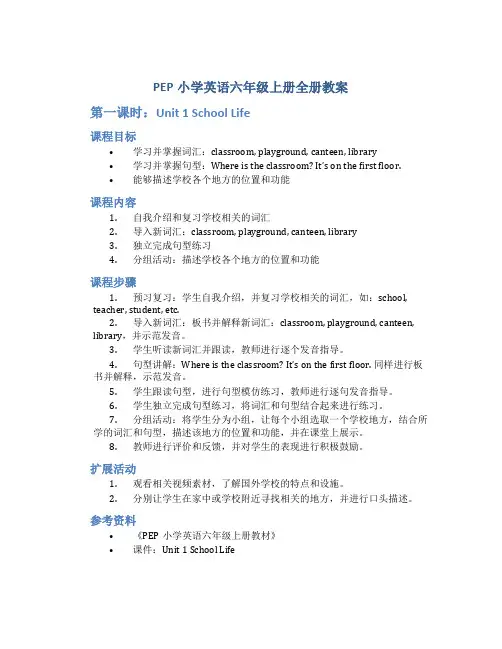
PEP小学英语六年级上册全册教案第一课时:Unit 1 School Life课程目标•学习并掌握词汇:classroom, playground, canteen, library•学习并掌握句型:Where is the classroom? It’s on the first floor.•能够描述学校各个地方的位置和功能课程内容1.自我介绍和复习学校相关的词汇2.导入新词汇:classroom, playground, canteen, library3.独立完成句型练习4.分组活动:描述学校各个地方的位置和功能课程步骤1.预习复习:学生自我介绍,并复习学校相关的词汇,如:school, teacher, student, etc.2.导入新词汇:板书并解释新词汇:classroom, playground, canteen, library,并示范发音。
3.学生听读新词汇并跟读,教师进行逐个发音指导。
4.句型讲解:Where is the classroom? It’s on the first floor. 同样进行板书并解释,示范发音。
5.学生跟读句型,进行句型模仿练习,教师进行逐句发音指导。
6.学生独立完成句型练习,将词汇和句型结合起来进行练习。
7.分组活动:将学生分为小组,让每个小组选取一个学校地方,结合所学的词汇和句型,描述该地方的位置和功能,并在课堂上展示。
8.教师进行评价和反馈,并对学生的表现进行积极鼓励。
扩展活动1.观看相关视频素材,了解国外学校的特点和设施。
2.分别让学生在家中或学校附近寻找相关的地方,并进行口头描述。
参考资料•《PEP小学英语六年级上册教材》•课件:Unit 1 School Life第二课时:Unit 2 Family课程目标•学习并掌握词汇:father, mother, sister, brother, grandparents•学习并掌握句型:This is my father. These are my grandparents.•能够介绍自己的家庭成员课程内容1.导入新词汇:father, mother, sister, brother, grandparents2.独立完成句型练习3.分组活动:介绍自己的家庭成员课程步骤1.导入新词汇:板书并解释新词汇:father, mother, sister, brother, grandparents,并示范发音。
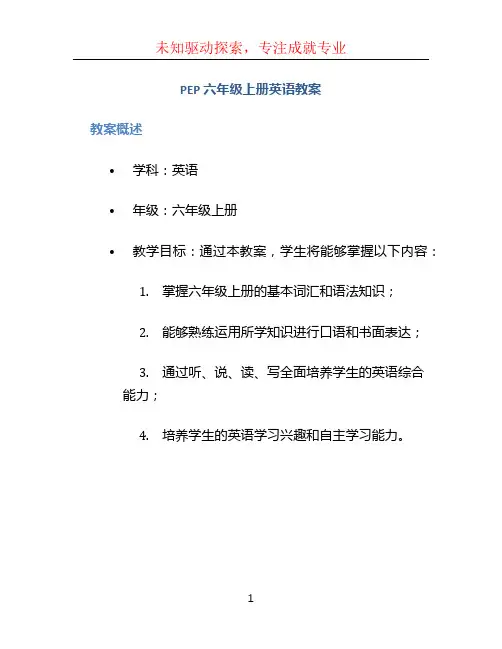
PEP 六年级上册英语教案教案概述•学科:英语•年级:六年级上册•教学目标:通过本教案,学生将能够掌握以下内容:1.掌握六年级上册的基本词汇和语法知识;2.能够熟练运用所学知识进行口语和书面表达;3.通过听、说、读、写全面培养学生的英语综合能力;4.培养学生的英语学习兴趣和自主学习能力。
教学内容和教学步骤Unit 1: My Family课时 1•课时目标:通过介绍家庭成员和描述人物特征,学生能够熟练掌握家庭成员的英文表达。
•教学重点:–学习并掌握家庭成员的英文表达;–学习并运用形容词描述人物特征。
活动一:Warm-up(15分钟)•教师与学生互动,介绍自己的家庭成员,并使用英文进行描述,引起学生的兴趣。
活动二:Presentation(30分钟)1.教师出示图片,介绍不同的家庭成员,如爸爸、妈妈、哥哥、姐姐等,并让学生跟读并模仿发音。
2.教师示范使用形容词描述人物特征,如tall(高个子)、short(矮个子),并让学生模仿。
活动三:Practice(25分钟)1.学生和教师进行对话练习,描述家庭成员的特征。
2.学生互相配对,通过描述对方的家庭成员,练习运用所学知识。
活动四:Consolidation(10分钟)1.教师用图片进行复习,并让学生回答问题,巩固所学知识。
2.课堂小结,师生共同总结本节课所学内容。
课时 2•课时目标:通过学习家庭成员的日常活动,学生能够运用所学知识描述家庭成员的日常生活。
•教学重点:–学习并掌握家庭成员的日常活动的英文表达;–运用所学知识进行日常生活场景的对话和表演。
活动一:Warm-up(15分钟)•教师通过幻灯片展示不同的家庭成员进行日常活动,并引导学生进行朗读和模仿。
活动二:Presentation(30分钟)1.教师出示不同的家庭成员在日常生活中的活动图片,并进行介绍和讲解,引导学生理解活动内容和相关词汇。
2.教师介绍日常活动的时间状语,如in the morning (早上)、in the afternoon(下午),并让学生跟读和模仿。
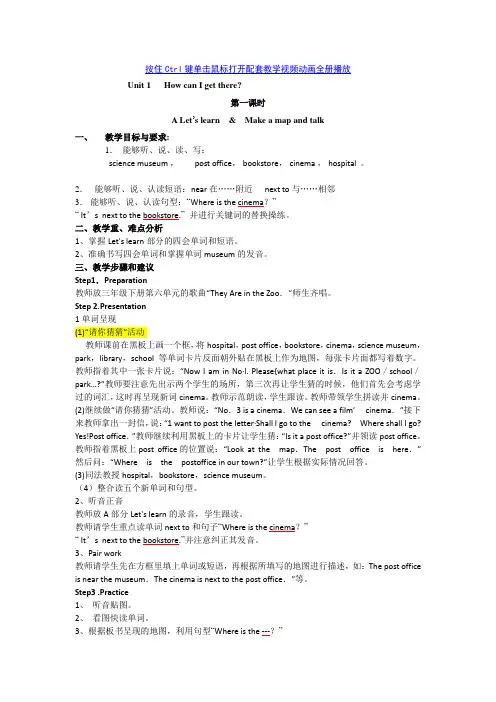
按住Ctrl键单击鼠标打开配套教学视频动画全册播放Unit 1 How can I get there?第一课时A Let’s learn & Make a map and talk一、教学目标与要求:1.能够听、说、读、写:science museum , post office, bookstore, cinema , hospital 。
2.能够听、说、认读短语:near 在……附近 next to 与……相邻3.能够听、说、认读句型:“Where is the cinema?”“ It’s next to the bookstore.”并进行关键词的替换操练。
二、教学重、难点分析1、掌握Let's learn部分的四会单词和短语。
2、准确书写四会单词和掌握单词museum的发音。
三、教学步骤和建议Step1.Preparation教师放三年级下册第六单元的歌曲“They Are in the Zoo.'’师生齐唱。
Step 2.Presentation1单词呈现(1)“请你猜猜”活动教师课前在黑板上画一个框,将hospital,post office,bookstore,cinema,science museum,park,library,school等单词卡片反面朝外贴在黑板上作为地图,每张卡片面都写着数字。
教师指着其中一张卡片说:“Now I am in No·l. Please{what place it is.Is it a ZOO/school/park…?”教师要注意先出示两个学生的场所,第三次再让学生猜的时候,他们首先会考虑学过的词汇,这时再呈现新词cinema。
教师示范朗读,学生跟读。
教师带领学生拼读并cinema。
(2)继续做“请你猜猜”活动。
教师说:“No.3 is a cinema.We can see a film’cinema.”接下来教师拿出一封信,说:“1 want to post the letter·Shall I go to the cinema?Where shall I go? Yes!Post office.”教师继续利用黑板上的卡片让学生猜:“Is it a post office?”并领读post office。

六年级上册英语备课Unit 1 How do you go there ?第一课时一、教学内容:PartA Let's learn部分二、教学目标:1.能够听、说、读、写短语:on foot,by bike,by bus,by train。
2.能够听、说、认读短语:by plane,by ship,by subway。
3.能用句子“How do you go to school?How do you go to Canada/…?”来替换有关询问别人的出行方式;并能够用句子“I go by…”进行回答。
4.能够听懂、会吟唱Let's chant的歌谣。
三、教学重难点:本课时的教学重点和难点是掌握四会短语和A Let's learn部分中运用某种交通工具去某地的表达法,并能替换关键词进行问答。
四、教学准备:1.教师准备录音机和本课时的录音带。
2.书上几种交通工具的图片及以前学过的几种交通工具的图片:car,boat,jeep,motorbike,还有脚的图片.五、预习提纲附县下发的预习提纲。
六、教学过程:(一)Warm---up (热身及预习展示)师生自由问答:T:Hello,nice to meet you!Ss:Nice to meet you!T:What's the weather like today?Ss:It's sunny!T:Can you spell "sunny"?Ss:Yes,S-U-N-N-Y,sunny.T:Good!What's this in English?Ss:A book.T:Yes,It's my book.T:Show me your fingers,please.Touch your nose,touch your face,touch your head...touch your foot.T:Good!Can you spell "foot"?Ss:Yes,F-O-O-T,foot.T:Good.This is a big foot.(出示脚的图片)Now,say after me.T:This is my foot.I have a big foot.Do you have a big foot?I can draw a foot....T:Look,one foot,two......Ss:Two feet.T:Good,two feet.I have two feet.How many feet do you have?How many feetcan you see?These are my feet.My feet are big.T:Look!I can draw a picture.(二)Presentation and practice(精讲点拨)(1)教师在黑板上画一座房子,说:This is my home..再画一所四层的大楼,为我们小学,(它们之间很近)教师画一条路,再画一个闹钟,说:"look,what time is it?”学生看后说;“It…s nine o‟clock.""Good,it's time to go to school!My home is near,I go to school on foot."教师边说边做背书包上学的动作,同时脚踏地慢慢往前走,让学生感受句型,教师多说几遍,把句型书写在黑板上,划出词组,让学生跟读,自己体会,让学生根据自己的实际情况来说自己是走路上学,体会on的意思.(2)教师再画一座房子,离学校很远,说:"Now,this is my home ,my home is here.It' s far from my school.I go to school by bike.(教师边说边做骑车的动作)"把此句型写在黑板上,教读,学生体会,并介绍自己是骑车来上学.(3)教师出示自行车的卡片,同时拿出别的交通工具的卡片,放在句型中bike 的上面,进行替换,学生说完整的句子,I go to school by ship.I go to school by bus.I go to school by plane.(4)出示train的图片,问:"What's this in English?Oh,it's a train.train.教师带领学生组词造句,巩固此单词.S1:This is a train.S2:I have a train.S3:There is a train.S4:I can see a train.S5:The train is on the desk.S6:How many trains can you see?S7:How many trains do you have?S8:I go to school by train.S9:I like train.S10:Where is my train.(5)以同样的方法教单词subway.(6)教师再带读一遍,把一本书卷成一个话筒,做采访人的样子,问一个程度较好的学生,教师可以帮助学生回答,T:Excuse me,How do you go to school?T and S:I go to school on foot.教师多问几位同学,让学生感受问句.教师书写问句,带领学生读,师生交换读,(多种方式读)(7)学生进行操练,先同桌互练,再在全班表演.(8)教师出示几个国家的国旗(图片)问学生:T:Look,is this Japan?Ss:No,it's Canada.T:Good,how do you go to Canada?Ss:(教师拿飞机的卡片)I go to Canada by plane.(9)学生反复造句,自由问答.(三)Consolidation and extension(拓展延伸)(1)让学生采访老师S:How do you go to school?T:I go to school on foot.S:How do you go to Canada?T:I go by plane.教师书写此句在黑板上,讲解省略的部分.学生补充完整省略的部分.(2)学生练习.(3)听磁带,跟读,感受语音语调.(四)Sum-up(总结)(五)The limited—time exercise (限时作业)学生做县下发的限时作业.(六)Check and explain(检查限时作业并反馈)学生互相批阅限时作业,发现问题,分析原因,并且反馈矫正。
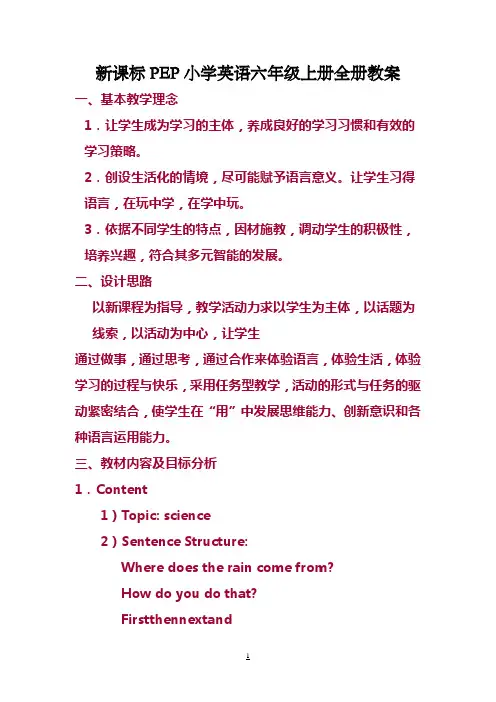
新课标PEP小学英语六年级上册全册教案一、基本教学理念1.让学生成为学习的主体,养成良好的学习习惯和有效的学习策略。
2.创设生活化的情境,尽可能赋予语言意义。
让学生习得语言,在玩中学,在学中玩。
3.依据不同学生的特点,因材施教,调动学生的积极性,培养兴趣,符合其多元智能的发展。
二、设计思路以新课程为指导,教学活动力求以学生为主体,以话题为线索,以活动为中心,让学生通过做事,通过思考,通过合作来体验语言,体验生活,体验学习的过程与快乐,采用任务型教学,活动的形式与任务的驱动紧密结合,使学生在“用”中发展思维能力、创新意识和各种语言运用能力。
三、教材内容及目标分析1.Content1)Topic: science2)Sentence Structure:Where does the rain come from?How do you do that?Firstthennextand3)Words: stream, vapor, seed, soil, sprout, rain, cloud, sun, plant2.Main Point:Reading of the story about water cycleDifficult Point:The ways to describe the process, e.g. Firstthennextand3.Goals1)知识目标:掌握课文单词和句子结构掌握音标与的长短区别读懂文章water cycle和painting,并能依照图片或范文进行仿写和填空2)能力目标:交流与合作日常生活常识的听说读写学习策略上学习归纳如何描述说明事物的过程“First, then, next, and或者first, second, third,等等”3)情感目标:科学合理有效地安排生活中的事物顺序,能对过程及程序给出自己的建议,学会仔细观察和科学有效利用时间。
通过对物质的几种形态变化的了解,培养学生的科学探究意识。

小学英语六年级上册全册教案1第〔1〕课时教学内容 A ’s ’s ’s教学目的1、学会’s 部分的几个新单词。
2、会娴熟运用….进展问话。
重点、难点:新单词的学习。
教学打算单词卡片录音机和磁带教学过程1、新课打算音标拼读练习。
2、导入新课(1) 在黑板上画一辆自行车。
引出.I .I .I .I .I .〞引出,, , ’s .(2) 利用上面的句子编一首.(3) 各种形式读(4) 老师不失时机地提出问题:引导学生利用学过的句子答复。
3、练习(1) 听录音。
(2) 出示单词卡片,让学生依据单词卡片组织对话。
4、作业(1) 英语作业本。
修改意见第〔2〕课时教学内容’s C部分’s教学目的1、能听、说、读、写四会驾驭句子:I . I . 并能在情景中正确运用。
2、可以表述自己以何种方式上学并简洁陈述缘由。
教学重点难点重点:听、说、读、写句型:I …难点:学生书写四会句子并能简洁陈述选择某种交通方式上学的缘由教学打算录音机和磁带单词卡片教学过程1、热身〔1〕复习上一课时对话〔2〕放’s 的歌曲2、预习〔1〕老师出示单词卡片,提问:〔2〕做’s 的题目。
3、新课呈现’s老师提问学生,通过体温,一步步地呈现课文内容。
并在黑板上重点板书以下单词:(由此引出) 〔由此引出〕四会句子的书写〔老师在课前打算四会单词的打乱词卡〕让学生把打乱的词卡的依次排列整齐。
老师让学生四人一组,通过提问:理解同学用何种交通方式上学,并激励学生简洁阐述缘由,如:. ’s . ’s . ’s …3、稳固和延长〔1〕完成作业本中的练习。
〔2〕完成抄写本中四会句子的书写作业。
修改意见第〔3〕课时教学内容 A ’s C教学目的1、可以充分理解并正确朗读对话,能完成文后答复下列问题的练习2、可以理解辅音及元音的发音规那么,并能读出相关例词3、理解部分的内容,可以识别常见的交通标记。
教学重点难点重点:学生可以充分理解并正确朗读对话。
难点:如何指引别人在不同地点换用不同的交通工具到达某一目的地。
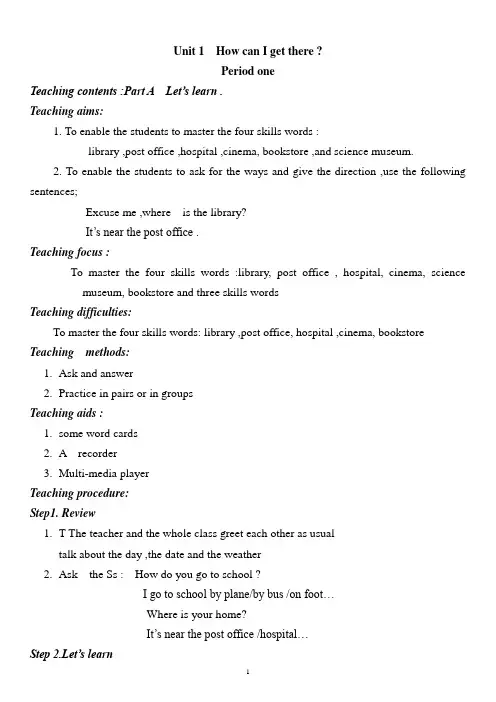
Unit 1 How can I get there ?Period oneTeaching contents :Part A Let’s learn .Teaching aims:1. To enable the students to master the four skills words :library ,post office ,hospital ,cinema, bookstore ,and science museum.2. To enable the students to ask for the ways and give the direction ,use the following sentences;Excuse me ,where is the library?It’s near the post office .Teaching focus :To master the four skills words :library, post office , hospital, cinema, sciencemuseum, bookstore and three skills wordsTeaching difficulties:To master the four skills words: library ,post office, hospital ,cinema, bookstore Teaching methods:1.Ask and answer2.Practice in pairs or in groupsTeaching aids :1.some word cards2.A recorder3.Multi-media playerTeaching procedure:Step1. Review1.T The teacher and the whole class greet each other as usualtalk about the day ,the date and the weather2.Ask the Ss : How do you go to school ?I go to school by plane/by bus /on foot…Where is your home?It’s near the post office /hospital…Step 2.Let’s learn1.Tell the students : I want to read some books :Where can I go ?(use the multi-mediaplayer) tell the Ss :I can go here ,then show the picture of library .Ask :Where is it ? It’s library. (word card)2.The teacher says:I have a new book. I bought o tom Xinhua bookstore .You can buy all kinds of books ther .Show “bookstore”3.The teacher takes out a letter and says : I want to post the letter .Can I go to thebookstore ?Where can I go ?4.We want to see a film ,Where can we go ? Teach :post office5.The teacher pretend to have a bad cold and says “I ‘m not well today .Where can Igo ?Teach “hospital”At last ,the teacher plays show the picture of science museum ,bank ,school ,zoo ,store ,supermarketStep 3. DrillUse the multi-media player to ask and answer :Teacher and students ,teacher and student .student and student Where is the ----? It’s near the ----?Step4. Homework1.Copy the new words on the EBplete the ABBb design:Unit Two How can I get there ?Where is the library /post office ---?It’s near ---.The second periodTeaching content : Pair workTeaching aims:1.To straighten the places: library post office hospital cinema bookstorebank science museum school supermarket etc.2.To master the sentences : Where is the museum?It’s in front of /near /next to/behind/far from---- Teaching focus:Ss can ask for the ways and give direction.Where is the -----?It’s -----.Difficulty points:The use of preposition : near in front of next to behind far from Teaching methods:Ask and answerTeaching aid:A recorder computerTeaching procedure:Step one: Review1.Revise the places what we have learnt yesterday.2.Dictation : library post office hospital cinema bookstore sciencemuseum .3.ask and answer. Where is the library ?It’s the post office.Step Two: Presentation1’lead in : in front of behind next to far fromSay: I stand in front of the blackboard. Or I stand in front of somebody.Somebody stands behind of me .S1 sit next to S2 .point to the other student ;I far farm S3.2.Encourage the Ss say: Where is the library?It’s near /in front of /behind/next to/far from----.Step Three:DrillAsk and answer several timesStep Four:HomeworkFinish the AB.Bb design:Sentences: Where is the museum?It’s in front of/behind/next to/far from----.New words:The third periodTeaching contents:Part A let’s try & let’s talkTeaching aims:1. To enable the Ss to master the four skills sentencesWhere is the cinema, please ?It’s next to the hospital.2. To improve the Ss listening ability.Teaching focus:To master the sentences of four skills and can use them freely. Teaching difficulties:1.Ask for the ways and give the direction. To involve these sentences.Where is the cinema /post office /library-----?It’s next to the hospital/bookstore/bank/science museum-----.。
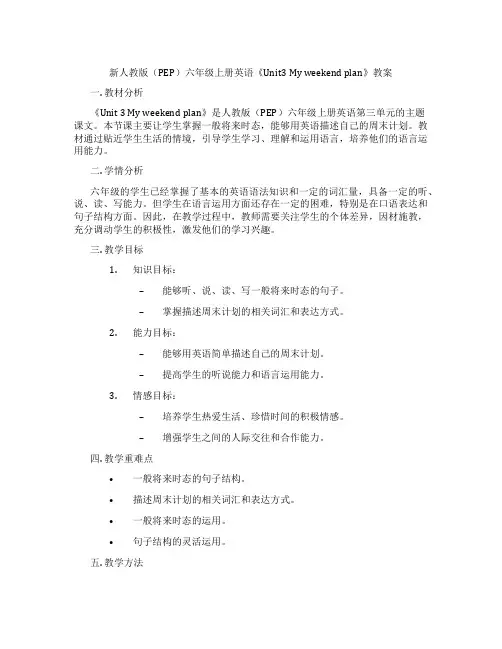
新人教版(PEP)六年级上册英语《Unit3 My weekend plan》教案一. 教材分析《Unit 3 My weekend plan》是人教版(PEP)六年级上册英语第三单元的主题课文。
本节课主要让学生掌握一般将来时态,能够用英语描述自己的周末计划。
教材通过贴近学生生活的情境,引导学生学习、理解和运用语言,培养他们的语言运用能力。
二. 学情分析六年级的学生已经掌握了基本的英语语法知识和一定的词汇量,具备一定的听、说、读、写能力。
但学生在语言运用方面还存在一定的困难,特别是在口语表达和句子结构方面。
因此,在教学过程中,教师需要关注学生的个体差异,因材施教,充分调动学生的积极性,激发他们的学习兴趣。
三. 教学目标1.知识目标:–能够听、说、读、写一般将来时态的句子。
–掌握描述周末计划的相关词汇和表达方式。
2.能力目标:–能够用英语简单描述自己的周末计划。
–提高学生的听说能力和语言运用能力。
3.情感目标:–培养学生热爱生活、珍惜时间的积极情感。
–增强学生之间的人际交往和合作能力。
四. 教学重难点•一般将来时态的句子结构。
•描述周末计划的相关词汇和表达方式。
•一般将来时态的运用。
•句子结构的灵活运用。
五. 教学方法1.情境教学法:通过设定生活情境,让学生在实际语境中学习和运用语言。
2.交际教学法:引导学生进行小组合作、角色扮演等互动活动,提高学生的语言运用能力。
3.任务型教学法:设计具有实际意义的学习任务,让学生在完成任务的过程中学习和运用语言。
六. 教学准备1.教材、课件和教学资源。
2.教学卡片、图片等辅助教具。
3.录音机、投影仪等教学设备。
七. 教学过程1.导入(5分钟)–教师通过提问方式引导学生谈论自己的周末计划,激发学生的学习兴趣。
–学生分享自己的周末计划,教师给予鼓励和反馈。
2.呈现(10分钟)–教师展示本节课的主题和目标,引导学生关注一般将来时态。
–通过图片、卡片等辅助教具,呈现描述周末计划的相关词汇和表达方式。
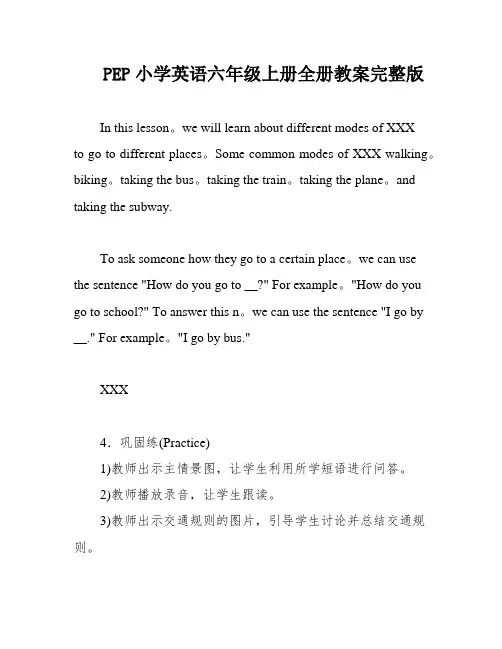
PEP小学英语六年级上册全册教案完整版In this lesson。
we will learn about different modes of XXXto go to different places。
Some common modes of XXX walking。
biking。
taking the bus。
taking the train。
taking the plane。
and taking the subway.To ask someone how they go to a certain place。
we can use the sentence "How do you go to __?" For example。
"How do you go to school?" To answer this n。
we can use the sentence "I go by __." For example。
"I go by bus."XXX4.巩固练(Practice)1)教师出示主情景图,让学生利用所学短语进行问答。
2)教师播放录音,让学生跟读。
3)教师出示交通规则的图片,引导学生讨论并总结交通规则。
5.课堂小结(Summary)本课我们研究了不同的交通方式,学会了如何用英语问别人如何去某个地方,以及如何回答这个问题。
同时,我们也研究了交通规则并了解了交通安全的重要性。
6.课后作业(Homework)1)完成Let'slearn部分的练。
2)写一篇短文介绍自己通常怎样去学校或其他地方。
注:本教案可根据实际情况进行适当调整。
1.教师可以通过自问自答的方式来引导学生研究交通方式的表达。
例如,教师可以问:“How do I go to school。
I go to school by bike.” 然后在黑板上写下“by bike”,并帮助学生说出完整的句子“ I go to school by…” 并将相应的短语写在黑板上。
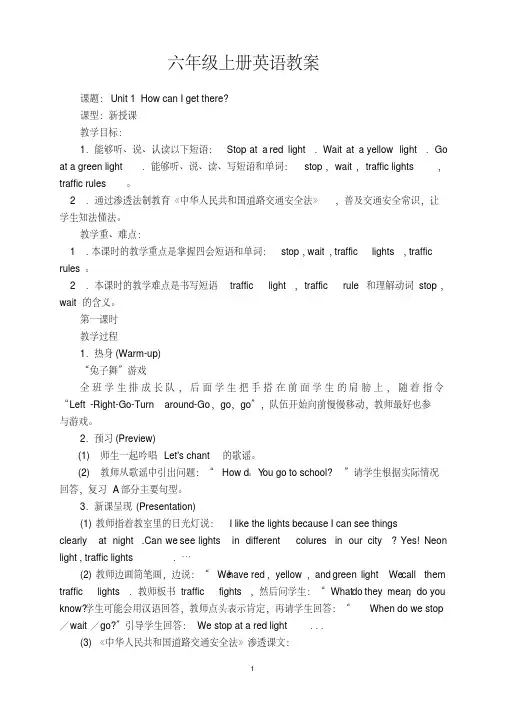
六年级上册英语教案课题:Unit 1 How can I get there?课型:新授课教学目标:1.能够听、说、认读以下短语:Stop at a red light.Wait at a yellow light.Go at a green light.能够听、说、读、写短语和单词:stop,wait,traffic lights,traffic rules。
2.通过渗透法制教育《中华人民共和国道路交通安全法》,普及交通安全常识,让学生知法懂法。
教学重、难点:1.本课时的教学重点是掌握四会短语和单词:stop,wait,traffic lights,traffic rules。
2.本课时的教学难点是书写短语traffic light,traffic rule和理解动词stop,wait的含义。
第一课时教学过程1.热身(Warm-up)“兔子舞”游戏全班学生排成长队,后面学生把手搭在前面学生的肩膀上,随着指令“Left-Right-Go-Turn around-Go,go,go”,队伍开始向前慢慢移动,教师最好也参与游戏。
2.预习(Preview)(1)师生一起吟唱Let's chant的歌谣。
(2)教师从歌谣中引出问题:“How d。
Y ou go to school?”请学生根据实际情况回答,复习A部分主要句型。
3.新课呈现(Presentation)(1)教师指着教室里的日光灯说:I like the lights because I can see thingsclearly at night .Can we see lights in different colures in our city ? Yes! Neon light , traffic lights.…(2)教师边画简笔画,边说:“We have red,yellow,and green light We call them traffic lights.教师板书traffic fights,然后问学生:“What do they mean,do you know?学生可能会用汉语回答,教师点头表示肯定,再请学生回答:“When do we stop /wait/go?”引导学生回答:We stop at a red light...(3)《中华人民共和国道路交通安全法》渗透课文:《中华人民共和国道路交通安全法》第二十六条交通信号灯由红灯、绿灯、黄灯组成。
最新人教版PEP小学六年级上册英语教案全套一、教案11. 教学目标- 研究和掌握关于家庭成员的英语词汇。
- 能够用英语描述家庭成员之间的关系。
- 能够正确运用句子结构"My {family member} is ... "进行句子构建和表述。
2. 教学准备- PPT课件- 黑板和粉笔- 卡片:含有家庭成员的图片和单词3. 教学过程1. 导入新课:通过展示家庭成员的图片,引导学生认识和复家庭成员的英文表达方式。
2. 复词汇:师生一起复家庭成员的英文单词,并进行拼读训练。
3. 句型讲解:通过示范和解释,教导学生使用句子结构"My {family member} is ... "来描述家庭成员。
4. 操练训练:使用图片和卡片,组织学生进行问答练,加深对家庭成员描述句型的运用。
5. 拓展活动:让学生运用所学知识,向同学们介绍自己的家庭成员。
4. 课堂总结- 复了家庭成员的英语词汇。
- 学会了使用句子结构"My {family member} is ... "来描述家庭成员。
- 运用所学知识进行了问答练和口头介绍。
二、教案21. 教学目标- 研究和掌握关于日常活动的英语词汇。
- 能够用英语描述自己和他人的日常活动。
- 能够正确运用句子结构"I {verb} ..."进行句子构建和表述。
2. 教学准备- PPT课件- 黑板和粉笔- 卡片:含有日常活动的图片和单词3. 教学过程1. 导入新课:通过展示日常活动的图片,引导学生认识和复日常活动的英文表达方式。
2. 复词汇:师生一起复日常活动的英文单词,并进行拼读训练。
3. 句型讲解:通过示范和解释,教导学生使用句子结构"I {verb} ..."来描述日常活动。
4. 操练训练:使用图片和卡片,组织学生进行问答练,加深对日常活动描述句型的运用。
5. 拓展活动:让学生运用所学知识,向同学们介绍自己和他人的日常活动。
pep小学六年级英语上册全册教案《PEP小学六年级英语上册全册教案》第一单元:Hello!教学目标:1. 能够听懂并正确模仿老师的问候语和自我介绍。
2. 能够正确朗读并书写单词hello、hi。
3. 能够在日常生活中灵活应用问候语,与他人进行简单交流。
课程安排:第一课:Hello!- 介绍问候语hello和hi,学生模仿老师的发音。
- 练习问候,学生之间互相问候并回答。
- 小组活动:四人一组,每人向其他三人问好并回答。
第二课:What's your name?- 介绍自我介绍的句型"What's your name?" "My name is ____." - 学生自我介绍,使用所学句型。
- 小组活动:学生两两进行自我介绍。
第三课:Nice to meet you!- 介绍句型"Nice to meet you!",学生模仿老师的发音。
- 学生之间进行简单对话,使用问候语和自我介绍句型。
- 小组活动:学生模拟真实场景,进行问候和自我介绍。
第四课:Goodbye!- 学习单词goodbye,并模仿老师的发音。
- 学习道别语句"Goodbye!",学生模仿老师的发音。
- 学生之间进行简单对话,使用问候语、自我介绍和道别语句。
- 小组活动:学生两两进行问候、自我介绍和道别。
第五课:Review- 复习本单元所学内容,对话练习。
- 小组活动:学生进行自由对话,运用本单元所学内容。
教学反思:通过本单元的学习,学生初步掌握英语问候语、自我介绍和道别语句的基本用法。
教师利用对话、模仿、角色扮演等多种教学方法,提高学生的参与度和实际运用能力。
小组活动的设置使学生能够在情景中灵活应用所学知识,增加学习的趣味性和成效。
同时,教师还要注重学生的发音和书写,引导学生正音正写,提高语言表达的准确性。
通过本单元的学习,学生将增强英语的学习兴趣,为下一个单元的学习打下良好基础。
新人教版(PEP)六年级上册英语《Unit 4I have a pen pal》教案一. 教材分析《Unit 4 I have a pen pal》是人教版(PEP)六年级上册英语教材的一单元,主要讲述关于介绍自己的朋友和了解朋友的情况。
本节课主要让学生掌握一般现在时的句型,并能运用所学知识进行简单的交流和描述。
通过本节课的学习,让学生能够更好地运用英语进行日常交流,提高他们的语言表达能力。
二. 学情分析六年级的学生已经掌握了基本的英语语法知识和词汇,具备一定的听说读写能力。
他们在学习本节课的内容时,能够较好地理解和掌握一般现在时的句型。
但部分学生对英语学习的兴趣较低,课堂参与度不高,因此需要教师在教学过程中激发他们的学习兴趣,提高他们的学习积极性。
三. 教学目标1.知识目标:让学生掌握一般现在时的句型,能够用英语介绍自己的朋友和了解朋友的情况。
2.能力目标:培养学生运用英语进行日常交流的能力,提高他们的语言表达能力。
3.情感目标:激发学生学习英语的兴趣,提高他们的学习积极性。
四. 教学重难点1.重点:一般现在时的句型及运用。
2.难点:一般现在时的动词变化和正确运用。
五. 教学方法1.情境教学法:通过设置情境,让学生在实际语境中学习和运用英语。
2.交际教学法:引导学生进行小组合作,进行实际的交流和互动。
3.游戏教学法:通过趣味性强的游戏,激发学生的学习兴趣,提高他们的学习积极性。
六. 教学准备1.准备相关图片、卡片等教学辅助材料。
2.设计好相关的教学活动和游戏。
3.准备好录音机、投影仪等教学设备。
七. 教学过程1.导入(5分钟)利用图片和卡片,引导学生谈论自己的朋友,为新课的学习营造一个轻松愉快的氛围。
2.呈现(10分钟)展示教材中的插图,引导学生观察并回答问题。
例如:“Who is pen pal? What does he/she look like? What does he/she like to do?”等。
Unit 1 How canI get there?第一课时A Let’s learn & Make a map and talk一、教学目标与要求:1.能够听、说、读、写:science museum ,post office,bookstore,cinema ,hospital 。
2.能够听、说、认读短语:near 在……附近next to 与……相邻3.能够听、说、认读句型:“Where is the cinema?”“It’s next to the bookstore.”并进行关键词的替换操练。
二、教学重、难点分析1、掌握Let's learn部分的四会单词和短语。
2、准确书写四会单词和掌握单词museum的发音。
三、教学步骤和建议Step1.Preparation教师放三年级下册第六单元的歌曲“They Are in the Zoo.'’师生齐唱。
Step 2.Presentation1单词呈现(1)“请你猜猜”活动教师课前在黑板上画一个框,将hospital,post office,bookstore,cinema,science museum,park,library,school等单词卡片反面朝外贴在黑板上作为地图,每张卡片面都写着数字。
教师指着其中一张卡片说:“Now I am i n No·l. Please{what place it is.Is it a ZOO/school/park…?”教师要注意先出示两个学生的场所,第三次再让学生猜的时候,他们首先会考虑学过的词汇,这时再呈现新词cinema。
教师示范朗读,学生跟读。
教师带领学生拼读并cinema。
(2)继续做“请你猜猜”活动。
教师说:“No.3 is a cinema.We can see a film’ cinema.”接下来教师拿出一封信,说:“1 want to post the letter·Shall I go to the cinema? Where s hall I go? Yes!Post office.”教师继续利用黑板上的卡片让学生猜:“Is it a post office?”并领读post office。
PEP六年级小学英语上册教案全册及反思目录•引言•教案一:Unit 1 Hello–教学目标–教学内容–教学步骤–教学反思•教案二:Unit 2 My Family–教学目标–教学内容–教学步骤–教学反思•教案三:Unit 3 My School Bag –教学目标–教学内容–教学步骤–教学反思•教案四:Unit 4 My Room–教学目标–教学内容–教学步骤–教学反思•总结引言《PEP六年级小学英语上册教案全册及反思》是对PEP六年级小学英语上册的教学教案进行总结和反思的文档。
本文档将会按照教学单元依次介绍每个教案的教学目标、教学内容、教学步骤以及教学反思,为教师们提供参考和借鉴。
教案一:Unit 1 Hello教学目标•学习并掌握问候语Hello、Hi、Good morning和Good afternoon的用法。
•能够准确使用问候语进行日常交际。
•能够听懂并模仿简单的日常问候对话。
教学内容•单词:Hello、Hi、Good morning、Good afternoon•日常问候对话教学步骤1.引入新课,通过播放问候视频引起学生的兴趣。
2.教师用图片和动作展示问候语,引导学生模仿。
3.学生进行角色扮演,在教师的引导下使用问候语进行对话。
4.教师播放听力材料,帮助学生听懂日常问候对话。
5.学生根据听到的对话进行回答,并模仿读对话。
6.教师布置家庭作业。
教学反思本节课通过生动有趣的视频、图片和角色扮演等教学方法,激发学生兴趣,帮助学生学习和掌握了问候语的用法。
通过听力训练和模仿对话,学生巩固了所学内容。
然而,由于时间限制,对于某些学生来说,练习的时间可能仍然不够,下次可以适当调整教学步骤,留出更多时间给学生进行练习。
教案二:Unit 2 My Family教学目标•学习并掌握家庭成员的称呼,如father、mother、brother、sister等。
•能够用英语介绍自己的家庭成员。
•能够听懂并模仿简单的家庭成员介绍对话。
Unit 1 How Do You Go There?第一课时教学设计第一课时一、教学目标与要求1.能够听、说、读、写短语:on foot,by bike,by bus,by train。
2.能够听、说、认读短语:by plane,by ship,by subway。
3.能用句子“How d0 you go to school? How do you go to Canada/…?”来替换询问别人的出行方式;并能够用句子“I go by…”进行回答。
4.听懂、会吟唱Let's chant的歌谣。
5.帮助学生了解交通规则,并在生活中自觉遵守交通规则。
二、教学重点、难点分析本课时的教学重点和难点是掌握四会短语和A Let's learn部分中运用某种交通工具去某地的表达法,并能替换关键词进行问答。
三、课前准备1.教师准备Let's start部分和主情景图的教学挂图。
2.教师准备录音机和本课时的录音带。
3.教师准备A Let's learn部分的单词卡片。
四、教学步骤1.热身(Warm-up)(1)复习副词:always,usually,often,sometimes,never的读音与词义。
T: When do you get up?/ When do you go to school?...(引导学生用always,usually,often,sometimes回答)(2)T:Today I go to school on bus. I usually go to school on foot. 教师利用肢体动作帮助学生理解句子意思。
T:What about you? Do you go by bike or by bus? Do you go on foot? Or by car?师生之间自由会话,引出几种常见的交通方式。
引导学生看本课Let’s start部分的标图并回答问题。